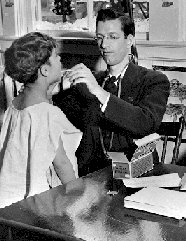Medical Inspection of Schools
The medical inspection of children in the public schools of British Columbia commenced in 1906. Trustees on the Vancouver School Board were concerned that "neither parent nor teacher is able to distinguish diseases of early childhood in their early stages," and so appointed a full-time medical inspector for Vancouver public schools in December 1906. Victoria School Board trustees, also eager to promote the health of public school pupils, appointed a medical inspector of school children early in 1907.1
In 1910, medical inspections were introduced province-wide under the authority of the Schools Health Inspection Act [10 Ed.7, c.45]. The Act made compulsory "the examination of every child as to the condition of sight and hearing, throat and teeth, or any other physical disability 'liable to prevent his receiving the full benefit of school work." British Columbia was the first province in Canada to pass such legislation. Under the terms of the 1910 Act, city school boards were to required to appoint and pay for a full time medical inspector who reported to the Provincial Board of Health (1899). In rural districts, the Board of Health appointed medical inspectors (often country doctors) and paid them 50¢ a mile for each mile travelled and 50¢ a head for each pupil examined. As well as examining school children, inspectors were required to investigate and report on the condition of school buildings and grounds, paying particular attention to heating, lighting, ventilation, and sanitary conditions.
Ruth (Wells) Sandwell focused on the medical inspection of schools in an extended research paper submitted for her M. A. (History) degree in 1981. In her view, the process was part of a larger movement instigated by urban, middle-class social reformers. "Medical inspection of the schools in British Columbia," Dr. Sandwell wrote, "provides one example of the assumption by the state of responsibilities formerly left to families, and an examination of the way medical inspections developed provides a close up view of this process. While medical inspections began as a specific response to the poor health of school children, as it evolved into a system of professional, state funded care for children, it did so on the basis of particular class-specific assumptions about the family, the role of the state, and the responsibility of the individual within it." (Wells, p. 59).Province-wide medical inspections commenced in January 1911 and the reports of medical inspectors were published in the British Columbia Sessional Papers (Provincial Board of Health Reports) in 1912. Transcripts of inspectors' reports for schools in Victoria and Vancouver Island in 1912 indicate how pupils and school facilities were scrutinized. In 1913, the provincial government issued a pamphlet, entitled Medical Inspection of Schools (1913). The pamphlet provided guidelines for teachers and inspectors, on how to assess and record the health of public school pupils.
The provisions of the Schools Health Inspection Act were incorporated into the Public School Act in 1924.
Written by Patrick A. Dunae
Notes
1Vancouver Daily Province, (8 February 1907), cited in Ruth Wells, "'Making Health Contagious': Medical Inspection of the Schools in British Columbia, 1910-1929" (Extended Research Paper for Master of Arts degree [History], University of Victoria, 1981), p. 22. See also Norah Lewis, "Physical Perfection for Spiritual Welfare: Health Care for the Urban Child, 1900-1939," in Patricia T. Rooke and R. L. Schnell (eds.), Studies in Childhood History. A Canadian Perspective, Calgary: Detselig Enterprises, 1982; and Mona Gleason, "Race, Class and Health: School Medical Inspection and 'Healthy' Children in British Columbia, 1890-1930," Canadian Bulletin of Medical History, Vol. 19, No. 1 (2002): 95-112.


